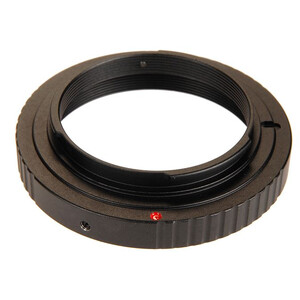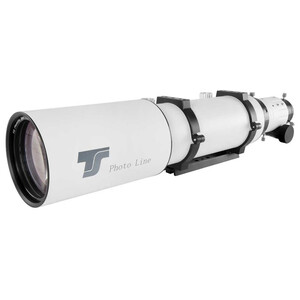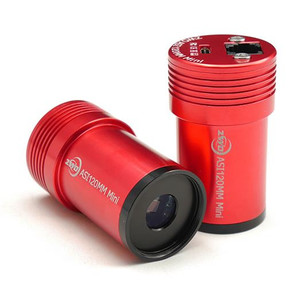The TS-Flatner has a calculated backfocus of 109mm. In practice, you can accept a tolerance of about one centimetre. A DSLR camera has a back focus of about 45mm. The T2 ring is about 1cm thick. So you still have to bridge about 6.5cm. If no
filter wheel or off-axis guider is to be used, a sleeve combination of 2 x
Baader Planetarium Hyperion finetuning ring 28mm
+
Baader Planetarium adapter thread 2''a/T2a
+
Baader Planetarium T2 intermediate ring 7.5 mm T2i/T2a
Depending on the camera model, a T2 ring is also required.
(Bernd Gährken)
Please note that the working distance between the thread shoulder of this flattener and your camera sensor will vary depending on the focal length of the instrument used.
It must be observed to achieve the best possible image quality.
Here are the distances for the same instrument focal length:
- Focal length < 450 mm: 128 mm
- Focal length 450-490 mm: 123 mm
- Focal length 500-550 mm: 118 mm
- Focal length 560-590 mm: 116 mm
- Focal length 600-690 mm: 113 mm
- Focal length 700-800 mm: 111 mm
- Focal length > 800 mm: 108 mm
Please note that this flattener has an M48 thread at the output.
Standard T2 rings have a thread diameter of 42 mm with a pitch of 0.75.
This is not directly compatible with this flattener.
You can use a "wide" T-ring, such as models 44351 (Nikon) or 44350 (Canon):
http://www.astroshop.de/fr/anneaux-t2/skywatcher-bague-m48x0-75-nikon/p,44351
http://www.astroshop.de/fr/anneaux-t2/skywatcher-bague-m48x0-75-canon/p,44350
http://www.astroshop.de/fr/anneaux-t2/baader-t-ring-fuer-sony-e-nex-bajonett-mit-d52-m48-und-t2-gewinde/p,49988#tab_bar_1_select
Here are some details about the optical designs of various rings of this type:
- Baader T M48 for A7s/E-Mount: 8.3 mm
- Orion Wide T Ring for Nikon: 8.1 mm
- Orion Wide T Ring for Canon: 10.9 mm
You will therefore need M48 extension tubes to compensate for the gap between the working distance of the flattener and the sensor of your imager.
We only have one M48 extension tube with a variable distance to allow for a little flexibility in the system:
http://www.astroshop.de/fr/tubes-d-extension/ts-optics-extension-m48-variable-17mm-23mm/p,48815
Here are the M48 extension tubes we have available:
http://www.astroshop.de/fr/tubes-d-extension/baader-hyperion-fine-tuning-anneau-14mm/p,8655
http://www.astroshop.de/fr/tubes-d-extension/baader-hypoerion-fine-tuning-anneau-28mm/p,8656
http://www.astroshop.de/fr/tubes-d-extension/ts-optics-tube-allonge-diam-50-8mm-2-avec-double-filetage-chemin-optique-5mm/p,43680
http://www.astroshop.de/fr/tubes-d-extension/ts-optics-tube-allonge-diam-50-8mm-2-avec-double-filetage-chemin-optique-10mm/p,43681
http://www.astroshop.de/fr/tubes-d-extension/ts-optics-tube-allonge-diam-50-8mm-2-avec-double-filetage-chemin-optique-15mm/p,43682
http://www.astroshop.de/fr/tubes-d-extension/ts-optics-tube-allonge-diam-50-8mm-2-avec-double-filetage-chemin-optique-30mm/p,43684
Alternatively, you can always reduce the thread to a T2 using a ring like this:
http://www.astroshop.de/fr/adaptateurs-et-bagues-de-reduction/ts-optics-adapter-m48-t2/p,46710
However, you will lose the benefit of the larger aperture of the ring, which limits the effects of the diaphragm.
This is particularly relevant with a 24*36 camera rather than with a standard APS-C format SLR.
For a CCD camera, refer to the dimensional drawing provided by the manufacturer.
As these cameras are generally T2, you will need to reduce to T2 as indicated above.
You will find at least two variable extension tubes in T2 and a plethora of fixed extension tubes in the same standard:
http://www.astroshop.de/fr/tubes-d-extension/baader-rallonge-t-2-verrouillable-20-29mm-varilock-29-avec-cle-de-serrage/p,17169
http://www.astroshop.de/fr/tubes-d-extension/baader-rallonge-t-2-verrouillable-29-46mm-varilock-46-avec-cle-de-serrage/p,17170
http://www.astroshop.de/fr/accessoires-pour-telescopes/adaptateurs/tubes-d-extension/15_37_10/a,Zubehoer.Leistung.Anschluss-Teleskopseitig=T2
Screw mounting is preferable to a series of interlocking extensions.
(Sandra Eguay)






